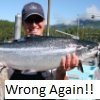Whole in the Water
Well-Known Member
These transfer conditions do not appear to require proof that the juvenile farm salmon have been tested for diseases or viruses before transfer. The licence does not explain "risk." Risk to shareholders, the other salmon in the pens or the wild salmon?
Money
By the time a farm-load of 600,000 to 1,000,000 Atlantic salmon is ready for transfer from a hatchery into marine net pens for grow out to harvest, the company has spent millions rearing them for a year in tanks on land. Each one has been injected with a vaccine to protect them from some diseases. If they can't be transferred into the ocean pens because of disease all that money is lost, as well as, the profits from the harvest.
Salmon farms are private businesses. Unfortunately they use public or common waters to flush all their waste and that means what goes on inside the pens has potential to affect the wild fish outside the pens. The legal mandate of a private company is to put the needs of the shareholder to make money first. This means the primary focus of the people working on the farm is the profitability of the farm itself. The legal mandate of the Minister of Fisheries and Oceans includes conservation and management of the public fishery, including the protection of the marine environment on which the public fish depend. So why has the Minister of Fisheries stepped back from this crucial decision?
Risk
Marine Harvest’s lawyers suggest the entire BC farmed salmon industry would be shut down if they could no longer use piscine reovirus infected fish. Therefore, it is important to them that the court believes piscine reovirus does not cause disease. Piscine reovirus is at the center of this test case, but the resulting decision will impact farm salmon infected with any virus or bacteria.
Piscine reovirus appears to cause heart damage in farmed salmon in Norway. Scientists warn a wild salmon infected with the virus might not be able to swim up a river, or even reach the river. If piscine reovirus affects Pacific salmon this way, the risk to Canada is incalculable. There is already evidence it is spreading in BC. BC government pathologist, Dr. Gary Marty reported he could not detect piscine reovirus in young wild salmon in the Broughton Archipelago in 2008 (Saksida et al 2012), but it is common to find it there today (my work, ongoing).
In Norway, non-government scientists have access to farmed salmon, but in Canada scientists who want to study farmed salmon have to buy them in the supermarket where the organs have been removed, so research is limited. One of the very few labs with access to BC farmed salmon is the BC Ministry of Agriculture's Animal Health Centre in Abbottsford. This lab has been responsible for the quarterly provincial farm salmon health audits that examine farmed salmon that have died. The pathologist at the Animal Health Centre has reported diagnostic symptoms of the disease associated with piscine reovirus, called HSMI, but inexplicably they do not believe it is HSMI. This does not make sense and deserves explanation. Download HSMI-type Lesion Reporting in BC
Cohen Commission
In his final report on the Inquiry into the Decline of the Sockeye Salmon in the Fraser River, Justice Bruce Cohen warned that the potential harm posed to Fraser River sockeye from salmon farm is serious or irreversible. He concluded that disease transfer occurs between wild and farmed fish, and he was satisfied that salmon farms along the sockeye migration routes have the potential to introduce exotic diseases and to exacerbate endemic diseases that could have a negative impact on Fraser River sockeye.
Further, he found that the risk of disease to wild fish has not been adequately studied. This is painfully clear with piscine reovirus, a highly infectious virus, associated with devastating impact on salmon health. No on knows what is happening to wild salmon that have been exposed to massive farm salmon populations infected with piscine reovirus. Maybe it is killing them, maybe it makes them too slow to catch food, or escape from whales, maybe it is doing nothing. "Maybe" is just not good enough when it comes to Canada's wild salmon. They feed over 100 species, support coastal and interior economies, they feed the trees that make the oxygen we breathe and pull the carbon that is causing climate change out of our atmosphere.
Your Attendance
I am very grateful for my legal team, for their brilliance and hard work in preparation for this, their workload is enormous. You can sit in on the proceedings June 11-13 in federal court, 701 W. Georgia St., Vancouver. Please respect the court, do not use your phone, laptop or any electronic device while in the building, turn your phone "mute." If you want to take notes use a pen and paper and if you want to post, tweet or email you can step outside.
I am hoping we can stop the spread of disease from farm salmon to protect the wild salmon of the Northeastern Pacific Ocean.
- See more at: http://alexandramorton.typepad.com/a....GtptOQyS.dpuf





